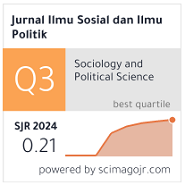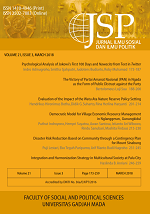Teungku Dayah Agency and Religious Social Capital on Drug Eradication in Aceh, Indonesia
Nirzalin Nirzalin(1), Yogi Febriandi(2*)
(1) Faculty of Social and Political Sciences, Universitas Malikussaleh
(2) Faculty of Syariah, IAIN Langsa
(*) Corresponding Author
Abstract
This article examines the success of religious social capital and the agency of teungku dayah (Islamic scholars who belong to traditional religious school) in the collective drug eradication movement in Ujong Pacu, Lhokseumawe-Aceh, Indonesia. The role of religious social capital in combating the drugs market in global drug policy has been less studied. This study provides a quite different view from most scholars who work for combating drug dealers by engaging participation of religious communities in rural society. The agency of teungku dayah succeeded in mobilizing the villagers due to the social capital that bonded the community based on religious ties. The article used live-in method, observation, in-depth and interviews to build a sociological imagination about the patterns of social practice of the people who become the subject of the research. The researchers lived in one of the villager’s houses, participated in their discussions, listened to the gossip, worshipped with them and were involved in certain jobs carried out by the community members who targeted informants. Using religious social capital, this article argues that teungku dayah effectively used the social and religious capital of the Ujong Pacu community to conduct drug eradication. Religious social capital has strong ties in unifying elements of the people in the same religion, moreover it becomes an energy that keeps motivating the community to run anti-drugs movement and driving out the drug addicts in Ujong Pacu, Lhokseumawe-Aceh.
Keywords
Full Text:
PDFReferences
Abdel Haleem, M., (2010). Qur’anic ‘jihād’: A Linguistic and Contextual Analysis, Journal of Qur’anic Studies, 12, 147-166. doi:10.3366/E1465359110000999.
Al-Omari, H., Hamed, R., & Tariah, H. (2015). The Role of Religion in the Recovery from Alcohol and Substance Abuse Among Jordanian Adults. Journal of Religion and Health, 54(4), 1268-1277. doi: 10.1007/ s10943-014-9868-5
Bokek-Cohen, Y., & Ben-Asher, S. (2018). How does it feel to be an anti-martyr’s widow? The interplay of religious capital and negative symbolic capital of war widows. Social Compass, 65(3), 395–412. doi: 10.1177/0037768618772967
Bourdieu, P. (1986). The forms of capital. In J. G. Richardson (Ed.), Handbook of theory and research for the sociology of education. New York: Greenwood Press. ISBN: 0313235295
Burger, J., & Kapron, M. (2017). Drug Policy and Indigenous Peoples. Health and Human Rights, 19(1), 269-278. Retrieved from http://www.jstor.org/stable/90007933
Campbell, H. (2014). Narco-Propaganda in the Mexican “Drug War”: An Anthropological Perspective. Latin American Perspectives, 41(2), 60-77. doi: 10.1177/0094582X12443519
Chen, Y. & Williams, M. (2016), Subjective well-being in the new China: religion, social capital, and social status. The British Journal of Sociology, 67, 719-746. doi:10.1111/1468-4446.12232
Coleman, JS. (1990). Foundations of social theory. Cambridge: Belknap Press of Harvard University Press. ISBN: 9780674312265
Deller, S. C., Conroy, T., & Markeson, B. (2018). Social Capital, Religion and Small Business Activity. Journal of Economic Behavior and Organization. 155, 365-381, doi: 10.1016/j.jebo.2018.09.006
Ferreira, R. (2015). The War On Drugs Addiction: The Role Of Misinformation In The Persistence Of U.S. Drug Policy. Revue Européenne Des Sciences Sociales, 53(1), 265-291. Retrieved from http://www.jstor.org/stable/43694331
Francis, J. M., Myers, B., Nkosi, S., Williams, P. P., Carney, T., Lombard, C., ... & Morojele, N. (2019) The prevalence of religiosity and association between religiosity and alcohol use, other drug use, and risky sexual behaviours among grade 8-10 learners in Western Cape, South Africa. PLoS ONE, 14 (2). doi: 10.1371/journal. pone.0211322
Herschinger, E. (2015). The Drug Dispositif: Ambiv alent Materiality And The Addiction Of The Global Drug Prohibition Regime. Security Dialogue, 46(2), 183-201. doi: 10.1177/0967010614552544
Ichwan, M. (2011). Official Ulema And The Politics Of Re-Islamization: The Majelis Permusyawaratan Ulama, Sharīʿatization And Contested Authority In Post-New Order Aceh. Journal of Islamic Studies, 22(2), 183-214. doi: 10.1093/jis/etr026
Kaasa, A. (2015). Culture, religion and social capital: evidence from European regions. International Journal of Sociology and Social Policy. 35(11/12), 772-794. doi: 10.1108/ IJSSP-11-2014-0110
Kaplowitz, T. (2015). School-Church/Synagogue Partnerships: A Comparative Case Study of Religious Capital Enrichment. Journal of Jewish Education, 81(3), 241-259. doi: 10.1080/15244113.2015.1063035
Kloos, D. (2014). In the Name of Syariah? Vigilante Violence, Territoriality, and Moral Authority in Aceh, Indonesia. Indonesia, (98), 59-90. doi: 10.5728/ indonesia.98.0059
Koram, K. (Ed.). (2019). The War on Drugs and the Global Colour Line. London: Pluto Press. doi: 10.2307/j.ctvdmwxn7
Lancee, B. (2012). Immigrant Performance in the Labour Market. Amsterdam: Amsterdam University Press. ISBN10 9089643575
Lindsey, T., & Nicholson, P. (2016). Drugs Law and Legal Practice in Southeast Asia Indonesia, Singapore and Vietnam. Oxford: Bloomsbury. ISBN-13: 978-1782258315
Ling, C., & Dale, A. (2013). Agency And Social Capital: Characteristics And Dynamics. Community Development Journal, 49(1), 4-20. doi: 10.1093/cdj/bss069
McRae, D. (2017). I nd o nes ian Capital Punishment in Comparative Perspective. Bijdragen Tot De Taal-, Land- En Volkenkunde, 173(1), 1-22. Retrieved March 31, 2020, from www.jstor.org/stable/26281573
Misāne, A., & Niklass, M. (2016). Social capital and religious and civic participation in Riga, Latvia: findings from the 2014 social survey. Religion, State and Society. 44(2), 172-184, doi: 10.1080/09637494.2016.1212525
Morello, G. (2019). The Symbolic Efficacy of Pope Francis’s Religious Capital and the Agency of the Poor. Sociology, 53(6), 1077–1093. doi: 10.1177/0038038519853109
Na, N. W. (2018). Opium Production and Countering Terrorism Financing in Afghanistan: Lessons from Thailand’s Royal Projects. Counter Terrorist Trends and Analyses, 10(2), 1-5. Retrieved March 30, 2020, from www.jstor.org/stable/26358992
Ng, V., Kissenkoetter, M., & Sorby-Adams, J. (2015). The Death Penalty for Drug Crimes in Asia Report. https://www.fidh. org/IMG/pdf/asia_death_penalty_drug_ crimes_fidh_wcadp_report_oct_2015_ pdf.pdf
Park, J. J., & Sharma, G. (2016). Religion and social capital: Examining the roles of religious affiliation and salience on parental network closure. Religion & Education , 43 (2), 162–177. doi:10.1080/15507394.2015.1048657
Patten, D. (2016). The Mass Incarceration of Nations and the Global War on Drugs: Comparing the United States’ Domestic and Foreign Drug Policies. Social Justice, 43(1 (143)), 85-105. Retrieved March 30,2020, from www.jstor.org/stable/24871302
Putnam, R. D., Leonardi, R., & Nanetti, R. Y. (1993). Making Democracy Work: Civic Traditions in Modern Italy. Princeton: Princeton University Press. ISBN: 9780691037387
Pettus, K. I. (2016). Churches and International Policy: The Case of the “War On Drugs,” a Call to Metanoia. Philosophia Reformata, 81(1), 50-69. doi:10.2307/26547898
Rademacher, M. A., & Wang, K. Y. (2014). Strong-Tie Social Connections Versus Weak-Tie Social Connections. Scholarship and Professional Work - Communication. 103. ttp://digitalcommons.butler.edu/ccom_papers/103
Sabarinah. (2019). Use of Drug Treatment and Re habilitatio n S ervic es in Indonesia: Findings of the 2014 National Narcotic Survey. Asia Pacific Journal of Public Health, 31(6), 548–558. doi:10.1177/1010539519872343
Schleifer, R., & Pol, L. (2017). International Guidelines on Human Rights and Drug Control: A Tool for Securing Women’s Rights in Drug Control Policy. Health and Human Rights, 19(1), 253-261.
Scott Jr, L. D., Hodge, D. R., White, T., & Munson, M. R. (2018). Substance use among older youth transitioning from foster care: Examining the protective effects of religious and spiritual capital. Child & Family Social Work, 23, 399-407. doi: 010.1111/cfs.12429
Smith, C. (2015). A Stranger in One’s Own Home: Surveillance, Space, Place, and Emotion during the GAM Conflict in Aceh. Indonesia, (100), 53. doi: 10.1353/ ind.2015.0011
Solagberu, A. (2015). The Influence of Shaykh Ibrāhīm Niyass on His Followers in Ilorin, Nigeria. Islamic Studies, 54(3/4), 217-236. Retrieved from http://www.jstor.org/stable/26393679
Van Ooyen-Houben, M., & Kleemans, E. (2015). Drug Policy: The “Dutch Model”. Crime and Justice, 44(1), 165-226. doi:10.1086/681551
Wormser, P. (2012). The Religious Debates of Aceh in the Sixteenth and Seventeenth Century: An Invisible Cultural Dialogue?. Journal of the Economic and Social History of the O ri ent , 55 (2/3), 369-382. doi:10.1163/15685209-12341239
Article Metrics
Refbacks
- There are currently no refbacks.
Copyright (c) 2020 Jurnal Ilmu Sosial dan Ilmu Politik

This work is licensed under a Creative Commons Attribution-NonCommercial-NoDerivatives 4.0 International License.






















